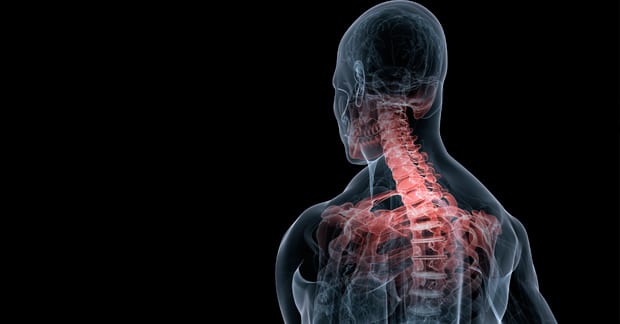Whiplash is an injury commonly associated with motor vehicle collisions (MVC) caused by a rapid forward and backward “whipping” of the neck. What varies between each case is the degree of injury and what anatomical parts of the neck are actually injured. Let’s take a look at the spine so we can better understand where the pain actually comes from…
The cervical spine is made up of seven moving vertebrae. The top vertebra (C1) is called the atlas and is shaped like a ring. This ring shape allows the head to rotate left and right so we can check traffic, carrying on conversation with someone sitting off to the side, and so on. It pivots around a peg called the “dens” of C2, or the axis, and the function of these first two vertebrae is very important. This is because the uppermost three nerves that exit through this part of the cervical spine innervate the head and dysfunction here may be the cause of some headaches. Chiropractic adjustments concentrate a great deal on restoring function to this area. The C4-6 vertebrae make up the most mobile region of the spine in the forward and backwards directions. Generally, the greater the mobility, the lesser the stability, and because of this, injury to this area is quite common. We often see arthritis in this region first and we focus on keeping the areas that are less mobile (areas above and below C4-6) as mobile as possible. The upper back/lower neck area includes the rib / vertebrae joints, which are also commonly involved in whiplash injuries. Chiropractic adjustments applied to this region also help to restore function and mobility. The thoracic spine is made up of twelve vertebrae and includes the rib cage as well as the shoulder blades (scapulae). This area is sometimes neglected during treatment as the main focus is often placed on the more painful areas of injury, like the neck. The lumbar spine consists of five vertebrae and is also frequently overlooked as an injured area due to its distance from the neck. However, seat belts frequently injure the breast, chest, mid-back, and/or low back regions.
There are several tissues that could be injured. The ligaments—the tough, non-elastic tissue that holds bone to bone—function to maintain stability between the vertebrae. The articular capsule is also made of ligaments and is a frequently injured area, which generates pain with movement of the head and neck. Muscles and their tendon attachments are elastic and function to move the structures. Stability is facilitated by good muscle tone and strength and is a strong focus of treatment. Injury to these structures are called “…soft tissue injuries,” and make up the majority of whiplash associated disorders (WAD II category).
The intervertebral disks are made up of a fibroelastic cartilage on the outside and a more liquid-like center that functions as shock absorbers between the vertebrae. Injuries to the disk can include tears, cracks, and/or fissures where the liquid center part can migrate through and can rupture. Injury to the nervous tissues includes the free nerve endings when the articular capsule is “sprained.” Nerve root injuries are most commonly “pinched” or compressed by a “ruptured disk” and send pain, numbness, and/or muscle weakness to specific areas of the arm and/or hand. These injuries are classified as WAD III injuries and usually carry a worse prognosis than WAD II injuries.
Determining which tissues are injured, managing the acute, subacute, and chronic stages of healing and facilitating self-management strategies are the primary goals of chiropractic treatment of the whiplash injured patient.
Thousands of Doctors of Chiropractic across the United States and Canada have taken "The ChiroTrust Pledge":
“To the best of my ability, I agree to
provide my patients convenient, affordable,
and mainstream Chiropractic care.
I will not use unnecessary long-term
treatment plans and/or therapies.”
To locate a Doctor of Chiropractic who has taken The ChiroTrust Pledge, google "The ChiroTrust Pledge" and the name of a town in quotes.
(example: "ChiroTrust Pledge" "Olympia, WA")
Content Courtesy of Chiro-Trust.org. All Rights Reserved.

